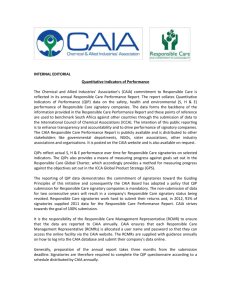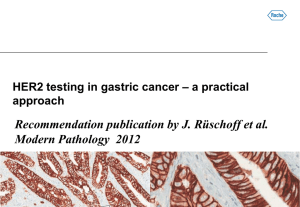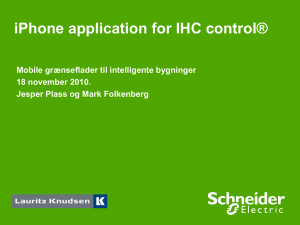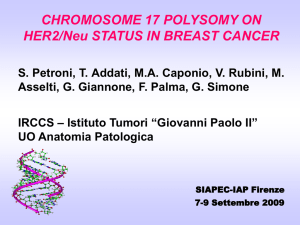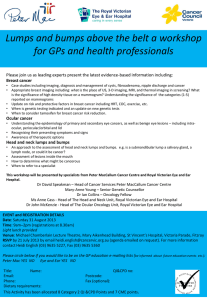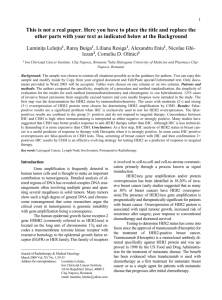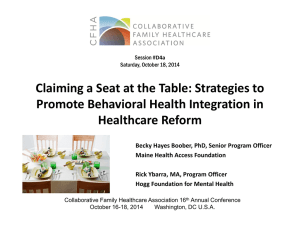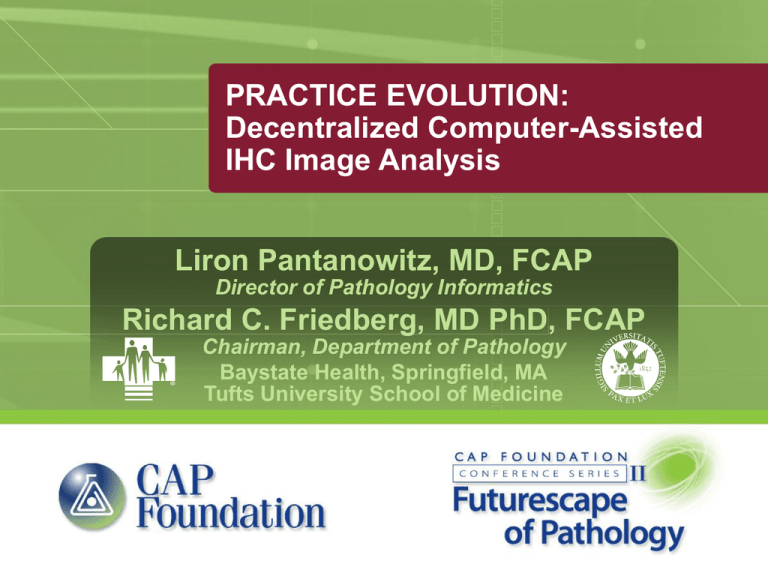
PRACTICE EVOLUTION:
Decentralized Computer-Assisted
IHC Image Analysis
Liron Pantanowitz, MD, FCAP
Director of Pathology Informatics
Richard C. Friedberg, MD PhD, FCAP
Chairman, Department of Pathology
Baystate Health, Springfield, MA
Tufts University School of Medicine
Why Are We Doing This?
• Practice Background
• Today’s Environment
Increased technological innovation
Increased biological information
Increased clinical demand
• Convergence of two independent long
term trends
Key Trend #1 in the Practice of
Anatomic Pathology
• Evolution along Clinical Pathology lines
Greater concern with analytical precision,
reproducibility, accuracy, specificity, reliability
Qualitative becoming quantitative
“Stains” becoming “assays”
Results directly tied to treatment, not just prognosis
Diminishing “guild” mentality with anointed experts
• Examples
IHC & ELISA
Her2/neu & Herceptin
Key Trend #2 in the Practice of
Anatomic Pathology
• Evolution along Radiology/Imaging lines
Analog images establish the field
Market & technology forces start trend to digital
imaging
• Initially, scanning of analog images
• Later, digitally acquired images
Digitalization of images allows new applications
Significant workload & throughput implications
• Examples
PACS
Convergence imaging
Windowing
Dynamic images
Telediagnostics
Expectations
• Eventually
Every “image-based” pathologist will use
computer-assisted analytic tools to assay
specimens
Intelligently designed PACS will revolutionize
pathology workflow
Increased reliance upon pathology
Breast Cancer &
Immunohistochemistry (IHC)
Determining breast tumor markers (ER, PR & HER-2/neu) for
prognostic & predictive purposes by IHC &/or FISH is the
standard of practice.
IHC score/quantification by manual microscopy is currently
accepted as the traditional gold standard.
Surgical Pathology workflow involves:
• Pre-analytic preparation (e.g. tissue fixation & processing)
• Analysis (i.e. staining of controls & patient slides)
• Post-analytical component (e.g. quantification & reporting)
Discrepancies between HER2 IHC & FISH mainly reflect errors
in manual interpretation & not reagent limitations (Bloom &
Harrington. AJCP 2004; 121:620-30).
Inter- & intra-observer differences in scoring occur:
• Most notably with borderline & weakly stained cases
• Related to fatigue & subjectivity of human observers
Accuracy is Required
Accuracy = the amount by which a measured
value adheres to a standard.
The need for precise ER, PR & HER2/neu status in
breast cancer is required to ensure appropriate
therapeutic intervention.
Lay press have communicated concerns over
inaccuracies in breast biomarker testing.
Threat of having to refer such testing to reference
laboratories.
Is computer assisted image analysis (CAIA) a
better (i.e. more accurate & reproducible) method
for scoring IHC?
Guidelines
ASCO/CAP Guideline Recommendations for HER2/neu testing in
breast cancer (Wolff et al. Arch Pathol Lab Med 2007; 131:18)
• Image analysis can be an effective tool for achieving consistent
interpretation
• A pathologist must confirm the image analysis result
• Image analysis equipment (including optical microscopes) must be
calibrated, subjected to regular maintenance & internal QC evaluation
• Image analysis procedures must be validated
Canadian National Consensus Meeting on HER2/neu testing in
breast cancer (Hanna et al. Current Oncology 2007; 14:149-53)
• Use of image analysis systems can be useful to enhance reproducibility
of scoring
• Pathologists must supervise all image analyses
FDA clearance for CAIA in vitro diagnostic use of HER-2/neu, ER, and PR
IHC has been obtained by several companies
CAIA vs. Manual Score
Remmele & Schicketanz. Pathol Res Pract 1993; 189:862-6
“Subjective grading of slides is a simple,
rapid and useful method for the
determination of tissue receptor content
and must not be replaced by expensive
and time-consuming computer-assisted
image analysis in daily practice.”
Data on CAIA & IHC
Early studies showed CAIA was no better than visual analysis
(Schultz et al. Anal Quant Cytol Histol 1992; 14:35-40)
Few studies have shown that manual & CAIA are comparable
(Diaz et al. Ann Diagn Pathol 2004; 8:23-7)
Most studies found CAIA to be superior to manual methods
(Taylor & Levenson. Histopathology 2006; 49::411-24; McClelland et al.
Cancer Res 1990; 50:3545-50; Kohlberger et al. Anticancer Res 1999;
19:2189-93; Wang et al. Am J Clin Pathol 2001; 116:495-503; Turner et al.
USCAP 2008 abstract 1694).
• Provides effective qualitative & quantitative evaluation
• More consistent than manual & digital microscopy
• More precise (scan per scan) than pathologists
One study showed agreement between different CAIA
systems: Chroma Vision ACIS & Applied Imaging Ariol SL-50
(Gokhale et al. Appl Immunohistochem Mol Morphol 2007; 15:451-5)
Published Considerations
Expense of CAIA may be hard to justify where
volumes are low
Image analysis frequently requires interactive
input by the pathologist
Increased time requirements
Systems may be discrepant when tumor cells
have low levels of staining
Interfering non-specific staining within selected
areas
Images must be free from artifacts
Small amounts of stained tissue can erroneously
generate lower scores
CAIA Systems
• ImageJ (NIH developed freeware)
• Adobe Photoshop software
(Lehr et al J Histochem Cytochem 1997; 45:1559-65)
• Automated Cellular Imaging System
(Chroma Vision)
• Pathiam (BioImagene)
• Applied Imaging Ariol (Gentix Systems)
• Spectrum (Aperio)
Image Analysis & Algorithms
Object-Oriented Image Analysis (morphologybased)
Involves
color
normalization,
background
extraction, segmentation, classification & feature
selection
Separation of tissue elements (e.g. tumor
epithelium) from background (e.g. stroma)
permits selection of areas of interest & filtering
out of unwanted areas
Region of Interest (ROI) is subject to further
image analysis (computation of diagnostic score)
Quantification of results
Digital Algorithm
Courtesy of BioImagene
Courtesy of BioImagene
Courtesy of BioImagene
Validation & Implementation
at Baystate Health
Distant medical centers
Significant breast IHC caseload
Need to mimic daily practice
• avoid central (single user) image analysis
Bandwidth limitations
Whole slide imager availability
Professional reluctance to read digital
images
Key Components
Multimedia PC upgrade
Spot Diagnostic digital cameras for each
workstation
Pathiam (BioImagene) web-based
application
Server (Oracle database + application +
image file storage)
Training & Validation
WORKFLOW
CONTROL IHC
PATIENT IHC
FOV ANALYSIS
REPORT GENERATION
NEED FOR
STANDARDIZATION
Calibrated Workstations
FOV IHC Analysis
FFPE breast cases routinely stained for ER, PR & HER2-neu
Standardized camera acquisition settings (calibration)
Pathologists (n=3) acquired 3-5 FOVs (each at 20x Mag.)
Uniform jpg image file formats used (4 Mb)
Post-processing image manipulation was avoided
Control parameter set defined/IHC run (default/modified)
ER/PR nuclear staining analyzed using the Allred scoring
system (i.e. proportion + intensity score = TS)
HER-2/neu membranous staining evaluated per ASCO/CAP
2007 recommendations (0, 1+, 2+, 3+)
Manual vs. CAIA comparison tracked (IHC score, time &
problems)
FISH for HER2/neu obtained on several cases
ER/PR Correlation (N=29)
Biomarker
ER+
Concordant Discordant
Cases
Cases
16
0
ER -
4
2*
PR+
14
0
PR -
4
3*
* 3 cases
HER-2/Neu Results (N=28)
CAIA
Manual Scoring
Score
0/1+
2+
0/1+
16
1*
2+
3+
FISH RESULTS:
* Negative (Ratio 1.04)
** Abnormal (Ratio 6.5)
3
3+
1**
4
HER-2/Neu FISH Correlation
Manual Score
CAIA Score
FISH Result
0
0
Negative (1.06)
0
0
Negative (0.93)
1
1
Negative (1.04)
1
0
Negative (1.00)
1
0
Negative (1.07)
1
0
Negative (1.66)
2
1
Negative (1.04)
3
2
Abnormal (6.5)
Challenging Cases
Infiltrating Lobular Carcinoma
Cytoplasmic Staining
Lessons Learned
Decentralized CAIA for IHC designed to
mimic daily surgical pathology workflow in
practice is feasible
Image acquisition requires standardization
Tissue heterogeneity may impact FOV
selection (whether biological or due to IHC
variation)
Pathologists must supervise CAIA systems
Future Prospects
Adopt virtual workflow-centric systems feasible for routine
practice (that may potentially show better results)
• E.g. Whole slide imaging (WSI) to eliminate the need to
standardize different systems
Automatic ROI selection & image analysis
Shortened analysis time
AP-LIS & CAIA system integration
• To improve workflow
• Permit disparate systems to access the same digital images &
case data
Learning algorithms
• Systems that improve with experience following pathologist
feedback
Clinical outcome studies are needed
• In one study, CAIA for ER IHC yielded results that did not differ from
human scoring against patient outcome gold standards (Turbin et al.
Breast Cancer Res Treat 2007)
Acknowledgements
Christopher N. Otis, MD
Giovana M. Crisi, MD
Andrew Ellithorpe, MHS
Peter Marquis, BA
BioImagene
TRANSFORMING PATHOLOGY:
Emerging technology driving practice innovation

